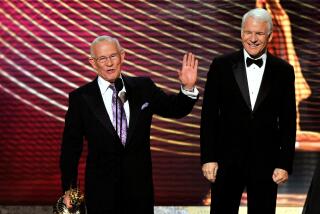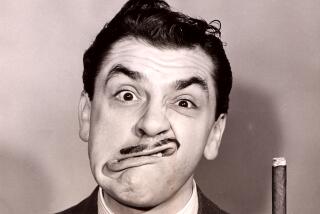Yes, by Gum, by Golly, Itās āKukla, Fran and Ollieā
They donāt make childrenās television shows like āKukla, Fran and Ollieā anymore. Of course, they didnāt back in 1947. But then puppeteer Burr Tillstrom created for the fledgling medium a whimsical universe populated by a cast of puppet characters that captivated generations.
For the next three decades, Tillstrom resisted making the show, in his words, ābig and noisy.ā He steadfastly retained its time capsule innocence. The production consisted of one set, one camera, one man behind the curtain and one woman, Fran, in front of it, extemporaneously interacting with his living dolls, who were dubbed the Kuklapolitan Players.
One might wonder if the late Tillstrom and his creations have a place in the big and noisy ā90s, but, to paraphrase their theme song: Here they are. Yes, by gum, and yes, by golly! Itās Kukla, Fran and dear olā Ollie, back with us again on videocassette. Episodes from the venerable and beloved series will be released next week on the New Kid Home Video label for the suggested retail price of $14.95 each.
The āKukla, Fran and Ollieā collection will launch with five volumes: āBe a Clown, Be a Clown,ā āGet on the Dragon Wagon,ā āKukla Discovers America,ā āMadame Oās Merry Musicaleā and ā āTis the Season to Be Ollie.ā These were among the 39 shows that were produced in 1971-72, 26 for PBS and an additional 13 when the show was bought for syndication. They represent the only color library of the show in existence.
Martin Tahse, who produced the last 13 episodes, bought the video rights for his Santa Monica-based video company, which also distributes his Peabody- and Emmy-winning āAfter School Specials.ā
Tillstrom was born in Chicago in 1917. His brother, Richard, says puppets were āin his blood all the way.ā
āHe used to rewire his teddy bears so he could manipulate them. When he was 8 or 9, he used to borrow our motherās old lace curtains, put them up on the kitchen window and use the shade as a curtain. Kids would stand outdoors and watch him perform a show.ā
In 1936, Tillstrom created a puppet character with an egg-shaped bald pate and bulbous nose. A ballerina, Tamara Toumanova, is said to have christened him Kukla, which is the Russian word for ādoll.ā Tone-deaf prima donna Madame Ooglepuss was next, followed by snaggletoothed Ollie J. Dragon. Other Kuklapolitan Players included floppy-eared Fletcher Rabbit and Buelah the Witch.
Tillstrom and company were among televisionās first stars. In 1940, sponsor RCA sent them to Bermuda to appear on the first ship-to-shore telecast. They also appeared on the premiere broadcast of station WBKB in Chicago in 1941 and later the first coast-to-coast network colorcast on NBC, on which they performed āSt. George and the Dragonā with Arthur Fiedler and the Boston Pops.
In 1947, Tillstrom invited radio actress and singer Fran Allison, whom he met at a war bonds rally, to join the troupe, and āKukla, Fran and Ollieā went on the air, live, five nights a week. The show was such a hit that bars turned off sporting events and stopped serving alcohol so families without television sets could come in and watch.
Tillstromās working method, which remained unchanged in his decades on the air, did not make the producerās task easy, although his professionalism did. Though songs were rehearsed, there was no script, because Tillstromās hands, occupied manipulating the puppets and props, could not have turned the pages.
āThere was no way I could creatively add to anything he did,ā Tahse said. āI could only step back and be ready for anything he needed. It was a one-camera show, so if he made a mistake, we would have had to start again at the beginning of the show, but in all the shows we did, we didnāt stop once.ā
Tahseās family did not own a television set, so āKukla, Fran and Ollieā was not a part of his childhood. It was as the producer of the national touring companies of Broadway plays that he was introduced to the show.
āWhen we played in Chicago, Burr made it a practice to invite the casts to attend the pre-broadcast warmup,ā he recalled. āHe went on around 6:30 p.m., which gave them plenty of time to get back to the theater. It was an āinā thing to do.ā
Celebrities who counted themselves as Kukla and Ollie fans include Carol Channing, who sent Ollie a silver stickpin, which he proudly displays on the video āMadame Oās Merry Musicale.ā
In 1952, before he was a celebrity, Stephen Sondheim wrote a song about Kukla and Ollie, āThe Two of You,ā which appears on the recording āUnsung Sondheim.ā
It was not until Tahse began to promote the videos, he said, that he fully appreciated just how beloved the show was to those who grew up with it and shared it with their own families. During a recent radio talk show appearance in Chicago, he took calls from fans in Florida, South Dakota and Nevada.
What is the secret of the showās timeless appeal?
āIts humanity,ā said Eda LeShan, one of Tillstromās closest friends, a family life educator and author who wrote an appreciation of Tillstrom for TV Guide after his death. āThere was something so sensitive, so charming and so very wise [about the shows] which is missing from so much we see today.
āThe puppets were an extension of his own inner life. They were so wonderful and so real that I felt totally involved with them. When he died, I was absolutely miserable, but I found I missed the puppets even more than I missed him.ā
(The actual puppets reside in the Chicago Historical Society, which owns the largest collection of āKukla, Fran and Ollieā memorabilia. The society is planning to put the items on display in July in honor of the showās 50th anniversary.)
āKukla, Fran and Ollieā was on the air until 1957. It was honored with Emmys and the Peabody Award. (Tillstrom also won an Emmy for the hand ballets he performed on the satirical TV series āThat Was the Week That Was.ā) The show returned to television on PBS in 1971 (these episodes are currently being broadcast on the Starz! cable channel). In addition, Tillstrom and company served as the hosts for the CBS series āChildrenās Film Festival.ā
Tillstrom died in 1985 (Allison in 1989). He always considered his creations to be live people, his brother noted, and just as he resisted the franchising of his characters (there were games and coloring books based on the show but no doll or puppet replicas), he also stipulated that no one was to manipulate the puppets after his death.
He was inducted into televisionās Hall of Fame a year later. Friend and Muppet creator Jim Henson, who acknowledged Tillstromās influence, performed the honors.
Richard Tillstrom said that although tastes and styles have changed, he believed that āKukla, Fran and Ollieā would once again find a welcome place in homes.
āBurr always felt like he was a guest in familiesā living rooms,ā his brother said. āThe show was quiet and gentle. There was never any meanness, and no one ever got hurt. It was living day to day with a family. Thatās what they became, a family.ā
More to Read
The complete guide to home viewing
Get Screen Gab for everything about the TV shows and streaming movies everyoneās talking about.
You may occasionally receive promotional content from the Los Angeles Times.






